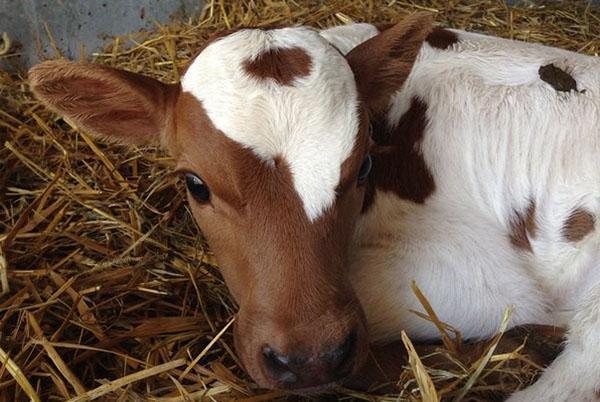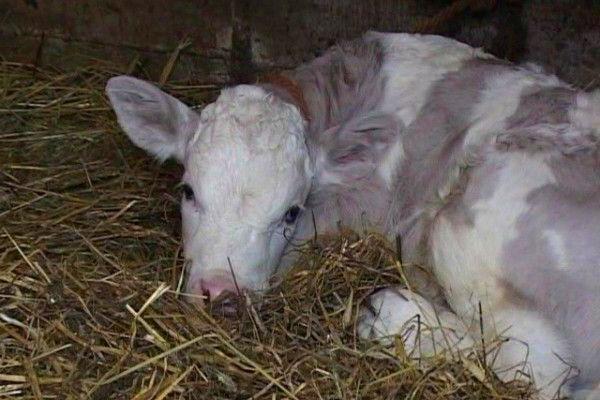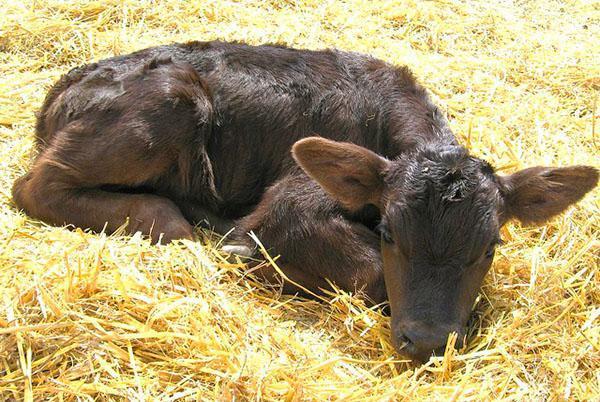Dyspepsia of newborn calves
 In the first days after birth, the calf has a weak immune system and an underdeveloped stomach. Therefore, he is extremely sensitive to diseases of any type, especially intestinal, for example, calf dyspepsia. Most often, this ailment affects animals due to improper feeding and poor care.
In the first days after birth, the calf has a weak immune system and an underdeveloped stomach. Therefore, he is extremely sensitive to diseases of any type, especially intestinal, for example, calf dyspepsia. Most often, this ailment affects animals due to improper feeding and poor care.
What is dyspepsia and what are the reasons for its occurrence

If urgent measures are not taken to treat a sick animal, then death due to dehydration of the body is inevitable.
The main symptoms of dyspepsia are calf diarrhea, lethargy.
Causes of occurrence:
- poor quality colostrum - during feeding, the cow did not receive enough nutrients or was fed with mediocre food;
- improper housing conditions: a small cage with a large number of calves, slush, drafts, dampness, cold;
- dirty feed containers;
- lack of walking;
- overfeeding;
- late start of the cow;
- cold or spoiled colostrum.
Due to the poor quality of the milk, the symptoms of the disease appear already 2 hours after the first feeding. As a result, the body is dramatically dehydrated and all metabolic processes slow down significantly, which negatively affects the growth and development of the calf. Calf dyspepsia can take two forms - mild and severe. The first type of disease is characterized by the following symptoms: poor appetite, lethargy and reduced interest in everything around, loose stools (about 2 times a day). If you start to treat the animal at this stage in time, then full recovery will come.
The severe form looks a little different: the calves lack appetite, the body temperature rises, and the skin becomes cold. Loose stools come out frequently, pulse is rapid. If you do not take urgent measures, animals die due to an excess of toxins (waste products of pathogens) and dehydration of the body within 2-5 days.
Treatment
Before you start doing something, if a calf is vilifying, it is necessary to separate it from other calves, for example, by moving it to a separate cage.
To treat dyspepsia, you need to apply a set of measures:
- regular and correct feeding;
- support of water and vitamin balance in the body;
- prevention of all fermentation processes in the intestine.
 Treatment depends on the severity. If the form is simple, then the reasons for the appearance of dyspepsia are identified, for example, poor-quality feed and improper feeding of a cow that gives colostrum. In this case, all sick animals are separated into clean cages and not fed for 6-12 hours. Only warm saline or 1% salt solution is dispensed from teat drinkers. On the first day, 1 or 2 times the feeding with colostrum is replaced with a 1% salt solution.
Treatment depends on the severity. If the form is simple, then the reasons for the appearance of dyspepsia are identified, for example, poor-quality feed and improper feeding of a cow that gives colostrum. In this case, all sick animals are separated into clean cages and not fed for 6-12 hours. Only warm saline or 1% salt solution is dispensed from teat drinkers. On the first day, 1 or 2 times the feeding with colostrum is replaced with a 1% salt solution.
 For the treatment of mild diarrhea in calves at home, various infusions have proven themselves excellent. For 1 kg of plantain or chamomile leaves, take 10 liters of boiled water.They are drunk before feeding with colostrum, 100-150 ml 2-3 times a day for two or three days. To normalize the work of the stomach for 5-7 days, gastric juice, diluted with 50% boiled water, is fed, 30-50 ml each. Additionally, acidophilus-broth cultures are issued, according to the doses indicated in the instructions.
For the treatment of mild diarrhea in calves at home, various infusions have proven themselves excellent. For 1 kg of plantain or chamomile leaves, take 10 liters of boiled water.They are drunk before feeding with colostrum, 100-150 ml 2-3 times a day for two or three days. To normalize the work of the stomach for 5-7 days, gastric juice, diluted with 50% boiled water, is fed, 30-50 ml each. Additionally, acidophilus-broth cultures are issued, according to the doses indicated in the instructions.
After a starvation diet, colostrum is fed in small portions (25% of the total volume), but often 5-6 times a day. Within 4 days, the portion is brought to normal.
If the form of the disease has become severe, then a large number of different drugs will be needed for treatment, administered orally through food (chloramphenicol, synthomycin and much more), intramuscularly (hydrolysin L-130, noliglobulins) and intravenously (Ringer-Locke's solution). Therefore, in this case, you should seek the help of a veterinarian, as you will need constant monitoring by a specialist.
To avoid the disease of cattle with dyspepsia and other intestinal infections or parasites, it is only necessary to maintain cleanliness, give full food and conduct an examination on time.

Colibacillosis and salmonellosis
Colibacillosis of calves can also cause diarrhea. This dangerous infection affects animals from 3 to 8 days of age. It occurs due to poor quality feed, vitamin deficiencies and improper care. It is transmitted most often through colostrum. For treatment, you will need antibiotics, drugs that neutralize toxins, hyperimmune serum. From folk remedies, infusions of chamomile, oak bark or St. John's wort are used.
 Calf salmonellosis is a dangerous infection, without timely treatment of which, livestock dies within 5-10 days. In this case, diarrhea also appears. If the form of the disease is mild, and the animal is strong, then after a while all the symptoms disappear, and the calf recovers. The severe type affects the respiratory tract, as a result, pneumonia occurs, which can lead to death.
Calf salmonellosis is a dangerous infection, without timely treatment of which, livestock dies within 5-10 days. In this case, diarrhea also appears. If the form of the disease is mild, and the animal is strong, then after a while all the symptoms disappear, and the calf recovers. The severe type affects the respiratory tract, as a result, pneumonia occurs, which can lead to death.
 To avoid the occurrence of colibacillosis and salmonellosis, it is necessary to vaccinate livestock. But first, it is necessary to conduct an examination to identify sick individuals, since vaccines can only be given to healthy ones.
To avoid the occurrence of colibacillosis and salmonellosis, it is necessary to vaccinate livestock. But first, it is necessary to conduct an examination to identify sick individuals, since vaccines can only be given to healthy ones.